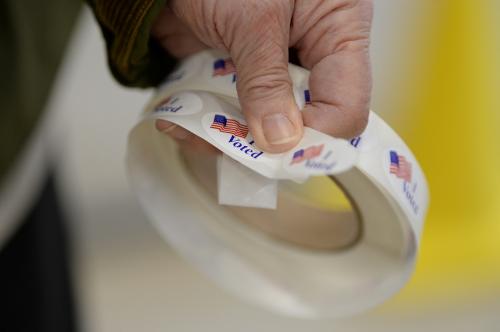elaine kamarck: Six trends show this is a positive sign for democrats
While Democrats were disappointed that John Ossoff did not win the special election in Georgia’s 6th District, they have other reasons to be optimistic about their prospects for 2018.
- Republican margins in special elections this year have shrunk.
- More voters currently identify as Democrats than as Republicans.
- Presidents in their first midterm almost always lose seats of their party.
- Low presidential approval ratings make the normal midterm losses greater.
- Hillary Clinton won 24 districts that Republican incumbents won.
- All of the above will help Democrats recruit “quality candidates” and may keep good candidates from running as Republicans.
I understand that this was a special election and that, as my colleague Molly writes, they don’t always predict future waves. But so far this year there have been two other special elections and while Republicans won both, their margins have shrunk. In Kansas-4 the Republican candidate won by 7 points; the previous incumbent won his last race by 31 points and Trump carried it by 27 points. In Montana’s At-Large seat, the Republican Greg Gianforte (famous for beating up a journalist) won the seat with a mere 50 percent of the vote. The previous Republican incumbent got 56 percent of the vote and Trump carried the state with 55 percent of the vote.
Of course smaller Republican margins in a few special elections does not a Democratic Congress make, but there are other indicators as well. For instance a recent Gallup poll showed that 45 percent of the country now identifies themselves as Democrats and 38 percent identify as Republicans—the largest gain recorded by Gallup in two years. Back in 2006 when Democrats picked up 30 seats to win control of the House of Representatives the Democratic lead in party identification was ten points and in 1998 when they picked up five seats (the first time since the Civil War that the party of the president had picked up seats in his second midterm election) the gap was 7 points in favor of the Democrats.
One of the most consistent findings in political science is that an incumbent president almost always loses seats in his first mid-term election. The average loss for a president’s party since 1862 is more than 30 seats. Obama lost 63 Democratic seats in the 2010 election. Clinton lost 54 Democratic seats in the 1994 election. The only exception to this rule is the 2002 election which occurred shortly after the 9/11 attacks when George W. Bush was still very popular.
An unpopular president can magnify the normal tendency to lose seats. The following chart from Gallup illustrates that low presidential approval ratings affect midterm losses. As Gallup’s Jeffrey Jones sums up: “Since 1946, when presidents are above 50 percent approval, their party loses an average of 14 seats in the US House in the midterm elections, compared with an average loss of 36 seats when presidents are below that mark.” The following table illustrates the trends in recent decades. Unless Trump can improve his approval ratings (which have been bouncing around in the high thirties to low forties), the normal losses could be exceeded.
| Year | President (Party) | % Approval, final Gallup poll before midterm | Seat gain/loss in U.S. House for president’s party | ||||
|---|---|---|---|---|---|---|---|
| 1998 | Clinton (D) | 66 | +5 | ||||
| 2002 | G.W. Bush (R) | 63 | +6 | ||||
| 1986 | Reagan (R) | 63 | -5 | ||||
| 1962 | Kennedy (D) | 61 | -4 | ||||
| 1954 | Eisenhower (R) | 61 | -18 | ||||
| 1990 | G.H.W. Bush (R) | 58 | -8 | ||||
| 1970 | Nixon (R) | 58 | -12 | ||||
| 1974 | Ford (R) | 54 | -43 | ||||
| 1978 | Carter (D) | 49 | -11 | ||||
| 1994 | Clinton (D) | 46 | -53 | ||||
| 1966 | Johnson (D) | 44 | -47 | ||||
| 1982 | Reagan (R) | 42 | -28 | ||||
| 1950 | Truman (D) | 39 | -29 | ||||
| 2006 | G.W. Bush (R) | 38 | -30 | ||||
| 1946 | Truman (D) | 33 | -55 | ||||
| Source: Gallup | |||||||
Hillary Clinton won 24 congressional districts where Republican Congressmen won. Congressmen from these districts are especially vulnerable in an off-year election with a president who did not win the popular vote and whose approval ratings are low. The following table shows those districts ranked by their vulnerability.
| State | District | Incumbent | Incumbent party | Margin of Clinton over Trump, 2016 |
|---|---|---|---|---|
| FL | 27 | Ros-Lehtinen, Ileana | (R) | 19.7 |
| FL | 26 | Curbelo, Carlos | (R) | 16.1 |
| CA | 21 | Valadao, David | (R) | 15.5 |
| VA | 10 | Comstock, Barbara | (R) | 10 |
| MN | 03 | Paulsen, Erik | (R) | 9.4 |
| CO | 06 | Coffman, Mike | (R) | 8.9 |
| CA | 39 | Royce, Ed | (R) | 8.6 |
| CA | 49 | Issa, Darrell | (R) | 7.5 |
| IL | 06 | Roskam, Peter | (R) | 7 |
| CA | 25 | Knight, Steve | (R) | 6.7 |
| CA | 45 | Walters, Mimi | (R) | 5.4 |
| AZ | 02 | McSally, Martha | (R) | 4.9 |
| NY | 24 | Katko, John | (R) | 3.6 |
| TX | 23 | Hurd, Will | (R) | 3.4 |
| CA | 10 | Denham, Jeff | (R) | 3 |
| WA | 08 | Reichert, David | (R) | 3 |
| PA | 07 | Meehan, Pat | (R) | 2.3 |
| TX | 32 | Sessions, Pete | (R) | 1.9 |
| CA | 48 | Rohrabacher, Dana | (R) | 1.7 |
| TX | 07 | Culberson, John | (R) | 1.4 |
| KS | 03 | Yoder, Kevin | (R) | 1.2 |
| NJ | 07 | Lance, Leonard | (R) | 1.1 |
| PA | 06 | Costello, Ryan | (R) | 0.6 |
Finally, and perhaps the most important reason these trends matter is that early indicators of party success will draw “quality candidates” into the congressional races. This concept was studied and proven back in 1989 by the political scientist Gary C. Jacobson who showed that “More high quality candidates run when prospects appear to favor their party…”
Unfortunately for American democracy, in any given election year an average of 13 percent of the House seats are uncontested[1] and others are contested by people who are not well known, not experienced and not well funded. This works in the other direction too. If a political party is facing a slew of negative trends, their best candidates may decide to sit out the election and wait for a more favorable year.
In spite of the disappointing outcome in Georgia’s sixth congressional district, there may yet be good news for Democrats seventeen months from now.
Molly reynolds: Broader partisan dynamics matter
How broad of a lesson should we draw from what happened in the special election in Georgia’s 6th district? Political science research suggests that, in recent years, presidential approval has become increasingly predictive of special election outcomes. In this way, special elections are structured like contemporary regular congressional contests, in that they are influenced heavily by national forces rather than local ones. Given Trump’s low approval ratings as compared to other recent presidents in June of his first term and indications that his popularity may be waning even among Republicans, a strong showing by the Democrat Jon Ossoff was unsurprising. In addition, the district has been trending in Democrats’ favor—the Cook Political Report ranks it as the 8th-most trending Democratic district in the country between 2013 and 2017. To the extent, then, that tonight’s result foreshadows anything about 2018, it’s to remind us that broader partisan dynamics are the major drivers of congressional elections. Wherever those stand next November is what’s likely to matter most.
Research suggests that, at least through 2008, seat pickups for one party in special elections corresponded to a good showing by that party in the subsequent general election. Democrats have certainly put in strong performances across this spring’s congressional races, even if they ultimately came up short. (In addition to the Georgia and South Carolina contests, Democratic candidates outperformed Clinton by 13 and 8 percentage points in Kansas and Montana, respectively.) At the same time, we should be wary of over-analyzing single outcomes. During the 111th Congress in 2009 and 2010, for example, Democrats managed to hold on in two close races and pick up a third seat from Republicans, only to see Republicans retake control of the chamber in 2010.
The Georgia race was the most expensive House race in history, with nearly twice as much spent as was in the previous record-holder. So much was allocated to advertising in Atlanta, the country’s 10th largest media market, that one local affiliate added an extra nightly newscast to take advantage of the ad revenue. Ossoff’s fundraising efforts clearly benefitted from mobilized, energetic Democratic activists in the aftermath of Trump’s victory. As reported by the New York Times, 86 percent of his individual itemized contributions came from donors outside of Georgia; for typical open seat House races, that share is generally much lower. From a fundraising perspective, then, the race was clearly an outlier; many donors likely saw it as delivering the most potential bang for their buck among the special elections happening this spring. Going forward, then, Democrats’ biggest challenge will be figuring out how to translate the ability to fundraise large amounts of money for a single race into the capacity to do so across many potentially vulnerable seats next year.
As Elaine points out, perhaps the most important lesson from the outcome is not whatever is learned by pundits, but what prospective Democratic candidates and Republican incumbents in other potentially vulnerable GOP-held seats around the country take away from the result. As I wrote in May, the choices by incumbents to retire and by high-quality challengers to enter congressional races can be an important signal of how both parties expect the next round of elections to proceed. A strong performance—even one that fell short of victory—by Ossoff and other Democrats nationwide may well play into the decision-making processes of incumbents and challengers alike in the coming weeks and months.
[1] Gerrymandering the House, 1972-2016, Table 1.








Commentary
What does the special election in Georgia mean for the 2018 midterms? Two perspectives
June 20, 2017